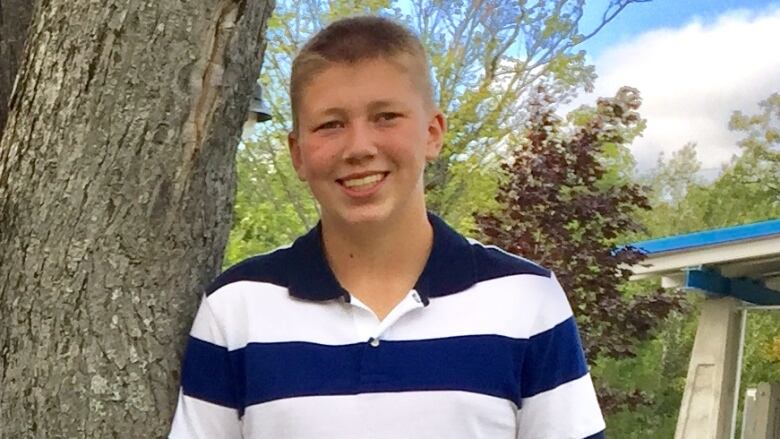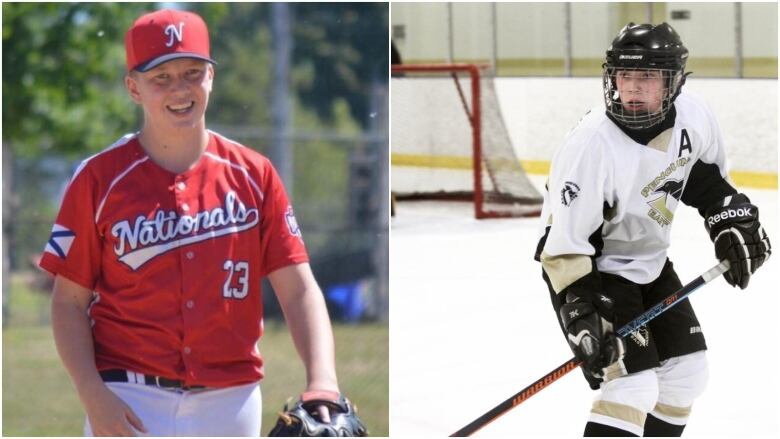Teen's death inspires community effort to get life-saving AEDs into schools
Braeden Bannister was 15 when he died in early November following a suspected cardiac arrest

The sudden death last fall of a 15-year-old athlete and volunteer firefighter from Lantz, N.S., has prompted fundraising efforts in his honour aimed atoutfitting area schoolswith life-savingautomated external defibrillators.
Braeden Bannister's family still doesn't know what exactly caused him to collapse and die following an eveninghunting tripNov. 1, but they suspect it was a cardiac arrest.
In his memory, the East Hants Fire Service purchased an automated external defibrillator for Braeden'sschool, Hants East Rural High. After realizing many other schools in the East Hants area also don't have the devices, the Bannister family decided it would be fitting to try to raise money for one or two more.
"They should be everywhere businesses and schools," said Braeden's father, Jeff Bannister.
"If it can save one life and help a family not have to go through the pain that we're going through, then it was well worth it. A small price to pay for a life. And equally important, these things need to be registered."
Used along with CPR, automated external defibrillators, known asAEDs, are devices that shock a person's heart when it is quivering erratically during a cardiac arrest and blood has stopped circulating.
The devices must be used as soon as possible aftersomeone's collapse. A person's chance of survival drops 10 per cent for every minute that passes without the help, making itcrucial that AEDs can beaccessed quickly.
When defibrillators are successful, a person's heart returns to a normal rhythm and circulation resumes. Defibrillators are often stationed in gyms, rinks and shopping malls.
When the fire departments donated the first AED, Bannister didn't know much about them, let alone how to use one.
"I probably would've been afraid to use it. Once it was explained to me, it's quite a simple process," he said. "I think itshould be in the schools so these kids have a basic training course on how to use them, if they had to use them. So their generation can grow up with these things."
So far, several businesses and community groups have pledged money for at least three other devices for the area's schools. Each costs upwards of $1,500.

On Saturday, afitness class was held in the gym at Maple Ridge Elementary, raising $2,700.All proceeds will go toward AEDs.
An avid baseball and hockey player, Braeden Bannister became a junior firefighter with the Lantz Fire Department last February. Jeff Bannister said it was ingrained in his son at a young age how important volunteers, like his coaches, were to Lantz and East Hants.
The teenager was also dedicated to his younger brother, Kevin, who has autism.
Braeden knew "the community has to grow and it has to be done on volunteer work, that's how the community has to operate," Jeff Bannister said, adding it's been heartwarming seeing people respond to the AED campaign.
"He'd be quite proud these things are getting put in the schools. And he was all about giving back," Bannister said.
"Hopefully all the schools in East Hants will get one. Hopefully the trend continues and maybe we can get them right through Nova Scotia or right through Canada."

There are about 70 AEDs located in schools across Nova Scotia. In an email, Chrissy Matheson, a spokesperson for theDepartment of Education, said in cases where students have a pre-existing condition requiring a defibrillator the educational centre will cover the cost.
There has been a push in other parts of the country to ensure defibrillators are available in all schools. Following a $1 million five-year Heart and Stroke campaign, there are nowdefibrillators in all schools in Newfoundland and Labrador. The P.E.I. government has also committed to installing devices in provincial schools.

The Bannisters also plan to ensure the new devices are included onNova Scotia's registry of AEDs.
Over the last two years, Emergency Health Services has put a big push on to keeptrack of the defibrillators sprinkled across the province. There are now 1,130 devices listed, up from just under 700 a year ago.
The province also publishes an interactive map showing the locations of registered defibrillators across the province. People can zoom in to see the devices closest to them, though EHS has cautioned the map is intended to educate peopleand not be counted on in an emergency as some AEDs may not always be accessible.
Despite the locations being recorded in an electronic database, when someone calls 911 in Nova Scotia in the case of a cardiac arrest, emergency dispatchers still aren't able to direct the caller to a nearby AED.
The province purchased software more than two years ago but it's been a "long and technically challenging" process to implement the new system, said Emergency Health Services spokesperson Remo Zaccagna.
He said there have been security and testing hurdles, but staff at the Medical Communications Centre have been trained on the system and should start using it sometime this year.
MORE TOP STORIES













_(720p).jpg)


 OFFICIAL HD MUSIC VIDEO.jpg)
.jpg)



























































































